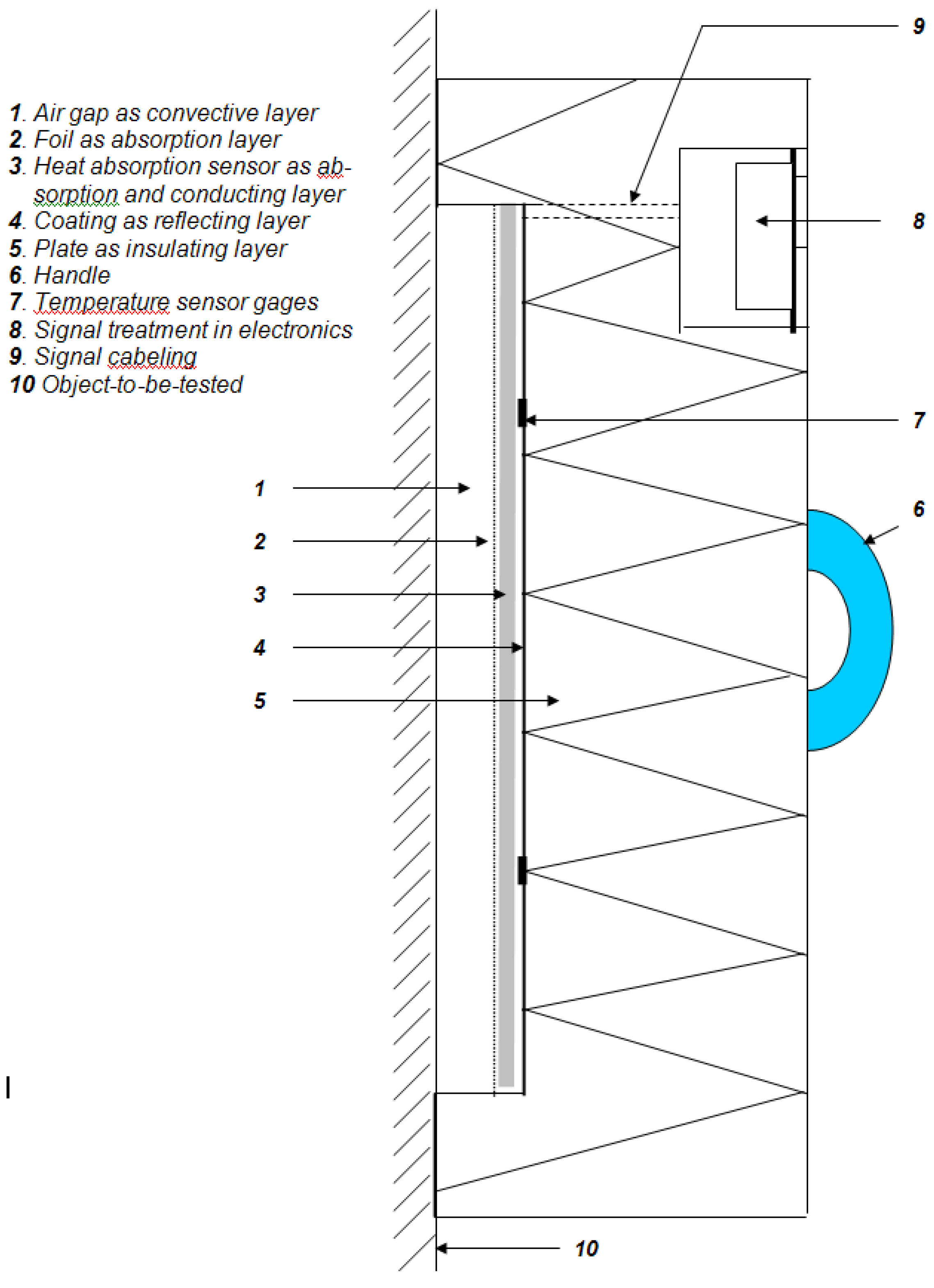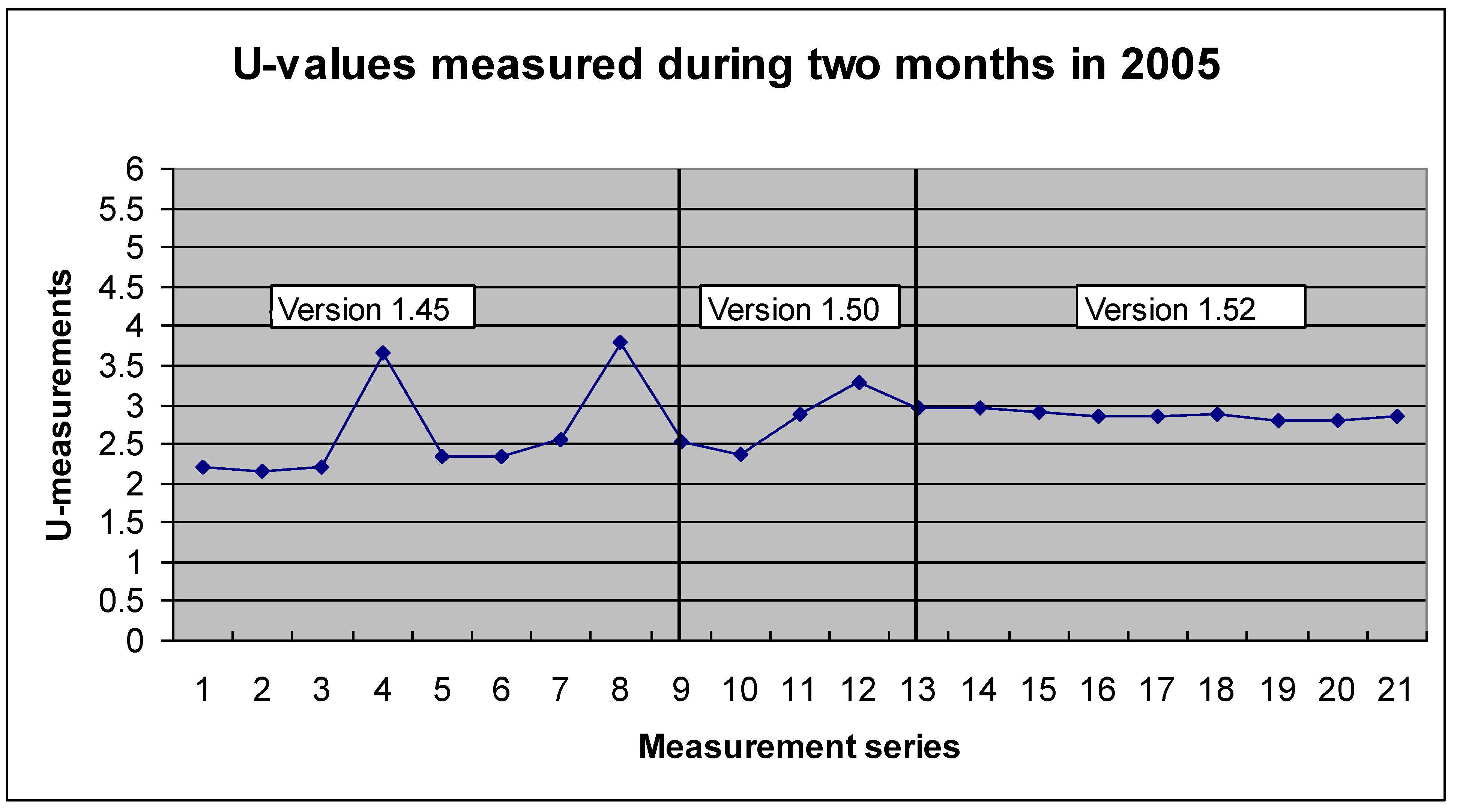Energy Renovation of Buildings Utilizing the U-value Meter, a New Heat Loss Measuring Device
Abstract
:1. Introduction
1.1. Introduction to Energy Renovation
1.2. Introduction to U-value Meter
2. Description of the U-value Meter
2.1. U-value Meter


- A steady state heat loss process is utilized
- The transition insulation factor problem is solved, by measuring implicitly via air gap/convector techniques
- An enthalpy based physical measuring principle is utilized
- Practical, current U-values (heat transmission coefficients) are measured
- No need to measure in the laboratory but outside the building
- The measurements are rapid
- Mobile equipment weighing less than 2 kg
- Easy to operate apparatus
- No need for to mount equipment on the test piece.
2.2. Main Processor
2.3. Measuring Procedure
- If the Meter is taken outdoors from an indoor environment the Meter has to be acclimatized to the outdoor temperature for a period of minimum half an hour. The display will show ‘Waiting’, until the Meter is in thermal equilibrium with its surroundings. While waiting, the Meter can display the difference between the reference sensor and the heat absorption sensor temperatures.
- After acclimatization the user is prompted to key in the indoor temperature. After that the user is asked to hold the reference sensor up in the air, and the outdoor temperature is measured for half a minute. During data acquisition these temperature values are given as input to the main processor. In fact, the outdoor temperature is continuously measured by the reference sensor and can be displayed at any time while the apparatus is turned on.
- When thermal equilibrium is reached, the display says ‘Ready’ and the user can initiate the measurement. If the user, by accident, turns the Meter towards the sun or puts his hand on the heat absorption sensor, causing a thermal rise in the heat absorption sensor, the processor will show the message ‘Waiting…’ again, indication lack of thermal balance. Thermal equilibrium is reached when the temperature difference between the heat absorption sensor and the reference sensor is below 0.3 °C.
- When the user holds the Meter against the test piece, the main processor starts to count the time and the measuring process is going on for the entire measuring period (20 seconds). The display shows ‘Measuring…’ and displays the temperature rise of the heat absorption sensor, while the measurement goes on.
- Immediately after the measurement is finished, the display says ‘Calculate…’ for a few seconds and the U-value is presented afterwards.
- The user can store the results in an internal memory by pressing the button ‘Memory’.
- The Meter will display ‘Waiting…’ until the heat absorption sensor is back in thermal equilibrium with the outdoor temperature, and after that a new measurement can begin.
2.4. Data Processing
- Low energy Battery Management. A single 9 V battery or 6 × 1.5 V batteries (rechargeable or single use) supplies current to all the features of the apparatus. Rechargeable batteries can be charged in the apparatus. Charger is supplied.
- Dot Matrix Display. The display is a green LED-display enabling to read in daylight as well as in dark if the measurements take place during the night.
- Main processor. This is where all the calculations are done, i.e., solving the formulas according to the principles described in section 2.2. The main processor is governed by software (approximate 800 lines of coding language C). Also the measuring procedure, including warnings etc. described in section 2.3 is handled in the processor.
- In-System Programming Interface. An adapter enabling programming of the apparatus’ main processor utilizing the coding language C.
- Data Acquisition System. Governing the data flow to and from the main processor.
- Thermal Sensor 4 point interface. Adaptor for signals from the four main sensors, placed on the heat absorption sensor and for the reference sensor as well.
3. Measurement Results and Uncertainties
| Example I | U1 | U2 | U3 | Expected U | Age |
| Terrace door | 1.35 | 1.33 | 1.31 | 1.20 | 6 years |
| LowE-glazed window | 1.24 | 1.27 | 1.30 | 1.20 | 6 years |
| Outer wall | 1.04 | 0.97 | 0.94 | 0.90 | 32 years |
| Example II | U1 | U2 | Expected U | Age |
| Double-glazed window | 3.00 | 3.15 | 2.80 | 36 years |
| Outer wall | 0.41 | 0.42 | 0.40 | 36 years |
| Example III | Umean | Expected U | Age |
| Double-glazed window | 2.87 (ver. 1.52) | 2.80 | 25 years |

| Umeasured | Date (2005) | Day/night | Wind | Sky | Tin | Tout | RH % | Note |
|---|---|---|---|---|---|---|---|---|
| 2.20 | 12. Jan. | Night | Mod. blowing | Cloudy | 21.0 | 4.2 | 73 | Ver. 1.45 |
| 2.14 | 13. Jan. | Night | Slight blowing | Cloudy | 20.6 | 3.6 | 70 | Ver. 1.45 |
| 2.20 | 14. Jan. | Daytime | Calm | Cloudy | 20.2 | 1.4 | 81.5 | Ver. 1.45 |
| 3.67 | 14. Jan. | Night | Calm | Starry | 20.6 | –4.0 | 80 | Ver. 1.45 |
| 2.33 | 15. Jan. | Daytime | Calm | Clear sky | 20.6 | –1.6 | 73.5 | Ver. 1.45 |
| 2.34 | 16. Jan. | Daytime | Slight blowing | Cloudy | 22.2 | 1.4 | 72 | Ver. 1.45 |
| 2.56 | 17. Jan. | Daytime | Slight blowing | Cloudy | 21.0 | 2.0 | 82 | Ver. 1.45 |
| 3.80 | 18. Jan. | Night | Calm | Haze | 20.8 | –1.4 | 78.5 | Ver. 1.45 |
| 2.53 | 21. Jan. | Daytime | Slight blowing | Hail shower | 20.0 | 0.4 | 72.5 | Ver. 1.45 |
| 2.36 | 23. Jan. | Daytime | Slight blowing | Slight cloudy | 19.8 | –1.2 | 78 | Ver. 1.50 |
| 2.87 | 26. Jan. | Night | Calm | Cloudy | 19.4 | –4.4 | 69.5 | Ver. 1.50 |
| 3.29 | 27. Jan. | Night | Calm | Cloudy | 20.2 | –2.4 | 76 | Ver. 1.50 |
| 2.95 | 29. Jan. | Night | Calm | Cloudy | 20.4 | –3.8 | 72.5 | Ver. 1.52 |
| 2.97 | 5. Feb. | Night | Calm | Starry | 21.2 | –2.0 | 71.5 | Ver. 1.52 |
| 2.90 | 6. Feb. | Daytime | Mod. blowing | Cloudy | 20.8 | –2.6 | 71 | Ver. 1.52 |
| 2.85 | 7. Feb. | Daytime | Calm | Unclouded | 21.0 | –3.7 | 75 | Ver. 1.52 |
| 2.84 | 7. Feb. | Night | Calm | Starry | 20.0 | –5.2 | 73 | Ver. 1.52 |
| 2.89 | 8. Feb. | Night | Calm | Starry | 18.2 | –5.0 | 65 | Ver. 1.52 |
| 2.80 | 13. Feb. | Daytime | Mod. blowing | Cloudy | 19.3 | –2.5 | 81 | Ver. 1.52 |
| 2.80 | 3. Mar. | Daytime | Slight blowing | Cloudy | 20.4 | –16 | 68 | Ver. 1.52 |
| 2.84 | 8. Mar. | Night | Calm | Slight cloudy | 20.8 | –2.1 | 70.8 | Ver. 1.52 |
4. Limitations of the U-value Meter
5. Case Study
5.1. Houses from the Nineteen-Twenties
5.2. House from the Nineteen-Seventies
6. Conclusions
References and Notes
- 22.000 kr. sparet på varmeregningen. 2009. Available online: www.rockwool.dk/nyheder+og+presse/ (accessed on 15 September 2009).
- Sørensen, L.S. Varmeudveksling under brandforløb. In Brandfysik og Brandteknisk Design af Bygninger, 1st ed.; Polyteknisk Forlag: Copenhagen, Denmark, 2004; pp. 167-198, 473-496. [Google Scholar]
- Sørensen, L.S. U-value Meter (Transmission Coefficient Measuring Apparatus). European Patent Application (EPA) No. 1,347,289, March 2003. [Google Scholar]
- Denmark Meteorological Institute Homepage. Available online: www.dmi.dk (accessed on 17 September 2009).
- Incropera & DeWitt, Fundamentals of Heat and Mass Transfer, 6th ed.; Wiley: Somerset, NJ, USA, 2006; Chapter 9.
- Andersen, E.S.; Jespergaard, P.; Østergaard, O.G. Fysik Kemi; F&K Forlaget: Copenhagen, Denmark, 1996; p. 154. [Google Scholar]
- Beregning af Bygningers Varmetab; Dansk Standard No. DS418; Dansk Standard: Charlottenlund, Denmark, 2006.
© 2010 by the authors; licensee Molecular Diversity Preservation International, Basel, Switzerland. This article is an open-access article distributed under the terms and conditions of the Creative Commons Attribution license ( http://creativecommons.org/licenses/by/3.0/).
Share and Cite
Sørensen, L.S. Energy Renovation of Buildings Utilizing the U-value Meter, a New Heat Loss Measuring Device. Sustainability 2010, 2, 461-474. https://doi.org/10.3390/su2020461
Sørensen LS. Energy Renovation of Buildings Utilizing the U-value Meter, a New Heat Loss Measuring Device. Sustainability. 2010; 2(2):461-474. https://doi.org/10.3390/su2020461
Chicago/Turabian StyleSørensen, Lars Schiøtt. 2010. "Energy Renovation of Buildings Utilizing the U-value Meter, a New Heat Loss Measuring Device" Sustainability 2, no. 2: 461-474. https://doi.org/10.3390/su2020461
APA StyleSørensen, L. S. (2010). Energy Renovation of Buildings Utilizing the U-value Meter, a New Heat Loss Measuring Device. Sustainability, 2(2), 461-474. https://doi.org/10.3390/su2020461




